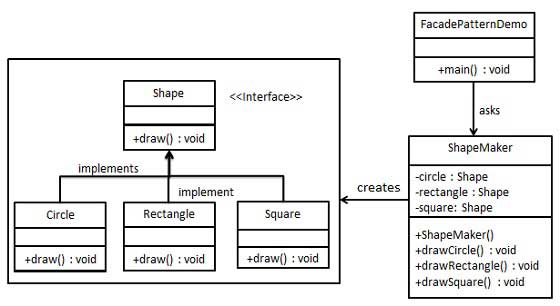外观模式隐藏了系统的复杂性,并为客户端提供了一个接口,客户端可以使用该接口访问系统。 这种类型的设计模式属于结构模式,因为这种模式为现有系统添加了一个接口以隐藏其复杂性。
此模式涉及单个类,该类提供客户端所需的简化方法,并将调用委托给现有系统类的方法。
举例说明
我们将创建一个 Shape 接口和实现 Shape 接口的具体类。 一个外观类 ShapeMaker 被定义为下一步。
ShapeMaker 类使用具体类将用户调用委托给这些类。 我们的演示类 FacadePatternDemo 将使用 ShapeMaker 类来显示结果。

第一步
创建一个接口
public interface Shape {
void draw();
}第二步
创建接口实现类
public class Rectangle implements Shape {
@Override
public void draw() {
System.out.println("Rectangle::draw()");
}
}
public class Square implements Shape {
@Override
public void draw() {
System.out.println("Square::draw()");
}
}
public class Circle implements Shape {
@Override
public void draw() {
System.out.println("Circle::draw()");
}
}第三步
创建外观类
public class ShapeMaker {
private Shape circle;
private Shape rectangle;
private Shape square;
public ShapeMaker() {
circle = new Circle();
rectangle = new Rectangle();
square = new Square();
}
public void drawCircle(){
circle.draw();
}
public void drawRectangle(){
rectangle.draw();
}
public void drawSquare(){
square.draw();
}
}第四步
使用其方法
public class FacadePatternDemo {
public static void main(String[] args) {
ShapeMaker shapeMaker = new ShapeMaker();
shapeMaker.drawCircle();
shapeMaker.drawRectangle();
shapeMaker.drawSquare();
}
}说明
外观模式是为多个复杂的子系统提供一个一致的接口,使这些子系统更加容易被访问。
或者换句话说是一个聚合模式,但是不太符合单一原则,改动一个地方有可能需要同步修改多个地方,需要仔细设计这个模式